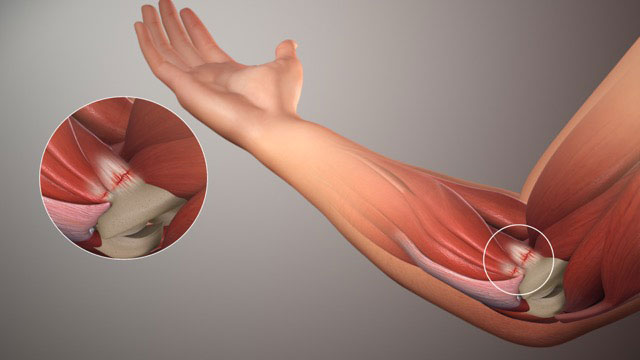Golfer's Elbow (Medial Epicondylitis) Overview
Medial epicondylitis, often referred to as "golfer's elbow," is a condition marked by small tears in the tendons of the elbow area (Figure 1). Golfer's elbow is a type of overuse injury that results after on-going trauma from repeated use of the arm and forearm muscles. This condition develops equally in men and women ages 20-49, and athletes whose sport requires repetitive wrist/forearm movement (e.g. golfers, baseball pitchers, bowlers, racquet sports) are at highest risk for developing this condition.
For those athletes at higher risk, who perform wrist/forearm movements regularly, maintaining muscle strength, using the right technique and decreasing the intensity of play can oftentimes prevent severe symptoms of. Strengthening the forearm muscles with squeezing a tennis ball, wrist curls, and reverse wrist curls can be effective in preventing this injury.
Anatomy
The elbow joint is made up of three bones: humerus (upper arm bone), radius (forearm bone on thumb side), and ulna (forearm bone on pinky finger side). The bony bumps at the bottom of the upper arm bone, near the elbow, are called epicondyles. Specifically, the bump on the inside of the bone is called the medial epicondyle, while the bump on the outside of the bone is called the lateral epicondyle. Ligaments, muscles, and tendons hold the elbow joint together. Medial epicondylitis involves inflammation of forearm tendons, specifically the tendons that help flex your wrist.
Symptoms of Medial Epicondylitis
Pain and tenderness associated with medial epicondylitis will occur on the inside of the elbow and will intensify with wrist and forearm motion, griping, and cocking. The medial epicondyle (bump on the inside of the upper arm bone) may also be tender to touch with or without visible swelling. Additionally, the pain may radiate up and down the arm. Numbness or tingling will often occur making the elbow area weak and stiff.
Diagnosis of Lateral Epicondylitis
Dr. Millett will perform a comprehensive history and physical exam of the elbow. He will consider how your symptoms developed, prior injuries, risk factors, and involvement in recreational sports. He will also use many elbow tests to assess range of motion and strength. Imaging such as X-ray, MRI, or EMG (to rule out nerve compression) may also be used.
Treatment for Medial Epicondylitis
Non-Surgical
As with many sports-related injuries, RICE is typically the first form of treatment.. RICE stands for: rest, ice, compression and elevation. If the injury is related to overuse of the wrist, refraining from the aggravating activity for a duration of time will often heal the injury. Over the counter medicines, such as ibuprofen or NSAIDS, may play a role in controlling pain and decreasing inflammation. Physical therapy can also help strengthen the muscles around the elbow and decrease pain. In some cases, a splint or brace will be recommended.
Surgical
If left untreated, golfer's elbow may require surgical intervention. Surgery to repair elbow epicondylitis is offered by Dr. Millett, and his preferred technique with debridement and repair of the damaged tendons is very effective. The procedure is a minimally-invasive, out-patient surgery that can have excellent results in patients who have failed a trial of non-surgical management.
For additional resources on golfer's elbow, or to discuss treatment options for medial epicondylitis, please contact the orthopedic office of Dr. Peter Millett.

